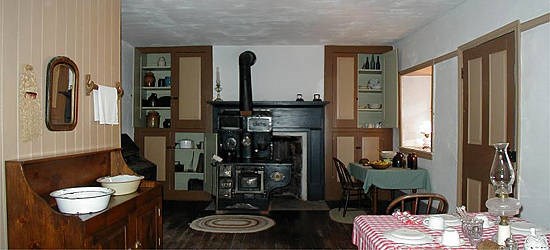|
The kitchen at Winsor Castle was the primary hub of activity. Children, adults, and guests had to be fed, most likely in shifts. The wood stove was probably rarely cool. |
Built-in cupboards housed many of the dishes and cooking utensils. There was no running water in the house other than the spring flowing underneath the floorboards of the parlor and through the spring room. A dry sink (shown to the left in the photo below) was used for washing dishes. The stove, manufactured in Chicago and installed while Edwin Dillworth "Dee" Woolley was ranch manager, had a reservoir on the right in which water could be heated (shown in the photo below). The stove, high-tech in its day, also featured a set of warming ovens above the cooking surface. If a family did not have a stove, cooking was done on the hearth, visible behind the stove in the photo below. The stove in the photo arrived in the late 1880s. Despite having a stove, some of the cooking may still have been done in the fireplace to help feed large numbers. | |

| ||
|
We know from journal entries of those living at Winsor Castle that it was a difficult house to keep clean. There were cattle (numbering in the thousands) on the range to the south, which came to Pipe Spring for water, as well as about 100 milk cows kept nearby. The cattle milling about outside the house pounded the earth to dust, which could easily enter the house through open gun ports through the cracks around windows and doors. |

Between meals, the dining table chairs were faced away from the table to remind the diners to kneel in prayer before sitting down to eat their meal. | |
Last updated: April 17, 2020
